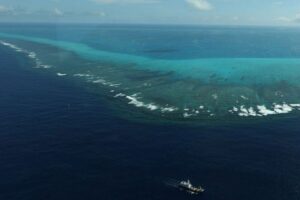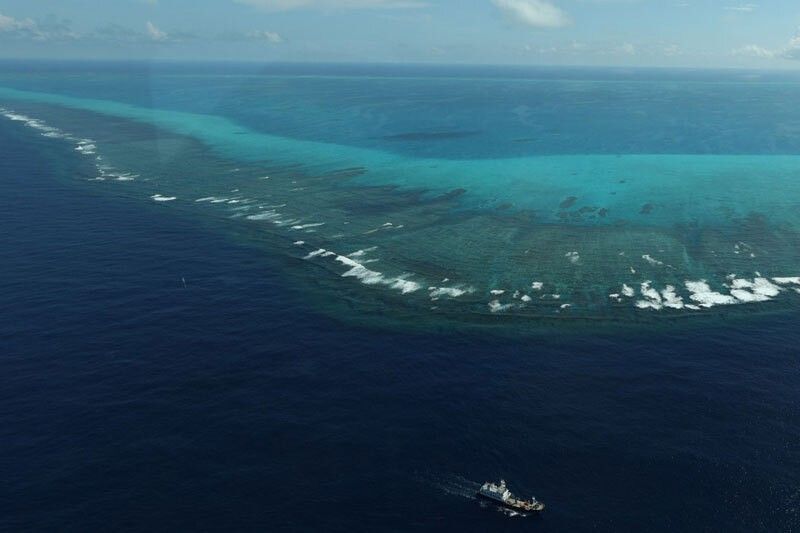
Philippines says Chinese vessels harassed its civilian ships at Sandy Cay

By Kenneth Christiane L. Basilio, Reporter
THE PHILIPPINES on Thursday accused China of endangering Filipino researchers in the South China Sea, saying its coast guard harassed two Philippine civilian vessels at a disputed reef on Wednesday, further raising tensions in the contested waterway.
The Philippine ships BRP Datu Sanday and BRP Datu Pagbuaya were on a routine scientific mission to collect sand samples at Sandy Cay, where they encountered “dangerous maneuvers and illegal acts” from Chinese coast guard and militia ships, according to Manila’s fisheries bureau.
The Chinese Embassy in Manila did not immediately reply to a Viber message seeking comment.
A Chinese coast guard vessel fired its water cannon at BRP Datu Sanday — the first time it has been used against Philippine ships at the disputed reef — before colliding the vessel, damaging its bow and chimney, the Bureau of Fisheries and Aquatic Resources said in a statement.
“Despite the aggressive interference, dangerous maneuvers and illegal acts by the China Coast Guard and Chinese maritime militia vessels, the Philippine scientific team was able to complete its operations in Pag-Asa Cays 1, 2 and 3,” the fisheries agency said, referring to the Sandy Cay features by their Filipino names.
“The incident occurred within the territorial sea of the Philippines,” it added.
The sandbars have become a flashpoint in the ongoing dispute between the two nations in the South China Sea, where they both lay competing claims. Confrontations between Manila and Beijing at other sea features have involved the use of water cannons and sideswipes by Chinese vessels on Philippine ships.
Manila has condemned such acts as aggressive and unlawful, while Beijing maintains its actions are meant to defend Chinese sovereignty.
China claims nearly all of the potentially mineral- and oil-rich South China Sea based on a 1940s nine-dash line map that overlaps with the exclusive waters of the Philippines and neighbors like Vietnam and Malaysia.
Chinese state media in mid-April reported that China’s coast guard had asserted sovereignty over the Sandy Cay by landing and displaying Beijing’s national flag on the feature.
But Manila has denied China’s claim over the sandbar, deploying its own contingent of troops shortly after to reinforce its position and challenge Beijing’s assertion of control.
The sandbank lies close to Thitu Island, where the Philippines maintains a military outpost and a small Filipino community has lived since 1971.
“Despite all the harassment, we’re still going to continue our maritime scientific research,” Philippine Coast Guard (PCG) spokesman for the West Philippine Sea Commodore Jay T. Tarriela told reporters on the sidelines of a maritime security forum in Manila.
“We’re still going to exercise our sovereignty and sovereign rights in the West Philippine Sea,” he added, using the Philippine name for parts of the South China Sea within the country’s exclusive economic zone.
Mr. Tarriela declined to say whether PCG vessels would escort future scientific research missions to the sandbars but confirmed that coast guard personnel were on board the ships during Wednesday’s operation.
SEA CODEMeanwhile, a Philippine state lawyer said on Thursday that the finalized code of conduct for the disputed South China Sea must align with international maritime law and uphold Manila’s arbitration victory over Beijing.
“The code of conduct should not have any provisions that would supervene the provisions of the United Nations Convention of the law of the Seas (UNCLOS),” Fretti G. Ganchoon, senior state counsel at Manila’s Justice department, told a maritime security forum.
“The UNCLOS is considered as the highest instrument of the Constitution for the oceans, and so the code of conduct must be consistent with it. It cannot have rules there that would, for example, impair the arbitral award,” she added.
Manila took legal action against China in 2013 over its blockade on Philippine vessels going to Scarborough shoal, a prime fishing ground claimed by both nations that Beijing has controlled since 2012.
In 2016, a United Nations-backed tribunal ruled that China had interfered with Filipino fishermen’s rights to access the area. It also voided its expansive sea claim in the contested waterbody for being illegal. Beijing has continued to deploy vessels around the maritime feature to assert its claim despite the ruling.
The Association of Southeast Asian Nations (ASEAN) and China pledged in 2002 to come up with a code of conduct on the South China Sea, a framework that seeks to prevent conflict through diplomatic means, but it has remained elusive due to slow progress.
Philippine Foreign Affairs Secretary Enrique A. Manalo last month said ASEAN and Beijing are “politically committed” to finalize the South China Sea code by next year, when the Philippines is set to host the regional grouping.
“At an early stage, we need to use the UNCLOS as a framework,” Hamzah bin Ishak, deputy director-general of national security at Malaysia’s National Security Council, said in the same forum.
“We are not living in the jungle, where people who are strong can do whatever they do,” he added. “We believe that UNCLOS remains relevant in disputes on the rights and responsibilities at sea.”
Mr. Hamzah said that “political solutions” outside the international treaty should only be explored if negotiations reach a deadlock. “I think ASEAN will continue to use the framework in the negotiations.”



